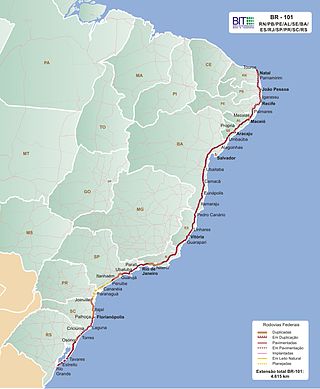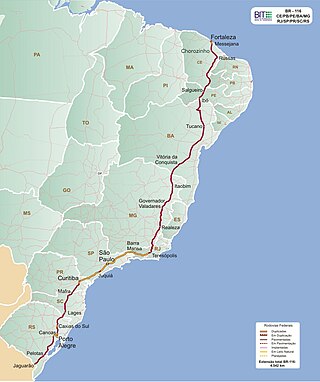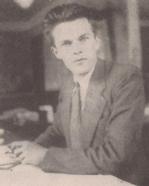
Paraná is one of the 26 states of Brazil, in the south of the country. It is bordered in the north by São Paulo state, in the east by the Atlantic Ocean, in the south by Santa Catarina state and the province of Misiones, Argentina, and in the west by Mato Grosso do Sul and Paraguay, with the Paraná River as its western boundary. It is subdivided into 399 municipalities, and its capital is the city of Curitiba. Other major cities are Londrina, Maringá, Ponta Grossa, Cascavel, São José dos Pinhais and Foz do Iguaçu. The state is home to 5.4% of the Brazilian population and generates 6.2% of the Brazilian GDP.

In Brazil, public holidays may be legislated at the federal, statewide and municipal levels. Most holidays are observed nationwide.

The BR-101 is a longitudinal highway of Brazil. It is the longest in the country with a length of nearly 4,800 km (3,000 mi), and it is considered one of the most important highways in the country, along with BR-116.

Alfredo Maria Adriano d'Escragnolle Taunay, Viscount of Taunay, was a Brazilian writer, musician, professor, military engineer, historian, politician, sociologist and nobleman. He is famous for the regionalist novel Inocência, considered a major forerunner of naturalism in Brazil, and for A Retirada da Laguna, an account of an episode in the Paraguayan War. The Brazilianist Leslie Bethell has described it as "the one undoubted literary masterpiece produced by the Paraguayan War".

Polish Brazilians refers to Brazilians of full or partial Polish ancestry who are aware of such ancestry and remain connected, to some degree, to Polish culture, or Polish-born people permanently residing in Brazil. Also, a Polish Brazilian may have one Polish parent.

Curitiba, Paraná, Brazil has a variety of landmarks.
Nordic Brazilians refers to Brazilians of full or partial Nordic ancestry, or Nordic-born people residing in Brazil.
Dalton Jérson Trevisan is a Brazilian author of short stories. He is described as an "acclaimed short-story chronicler of lower-class mores and popular dramas." Trevisan won the 2012 Prémio Camões, the leading Portuguese-language author prize, valued at €100,000.

The Federalist Revolution was a civil war that took place in southern Brazil between 1893 and 1895, fought by the federalists, opponents of Rio Grande do Sul state president, Júlio de Castilhos, seeking greater autonomy for the state, decentralization of power by the newly installed First Brazilian Republic.

BR-116 is a federal route of highways of Brazil and the longest highway in the country, with 4,542 km (2,822 mi) of extension. The road connects Fortaleza, Ceará, one of the largest Northeast Brazil metropolises, to the southern city of Jaguarão, Rio Grande do Sul, in the border with Uruguay. It is also the longest highway in the country to be completely paved. It is considered one of the most important highways in the country, along with BR-101.

Cristóvão Tezza is a Brazilian novelist and university professor.

Events in the year 1933 in Brazil.

Events in the year 1948 in Brazil.
Renina Katz Pedreira, known as Regina Katz, is a Brazilian engraver, printmaker, and watercolorist. Together with Edith Behring and Fayga Ostrower, she is part of the generation of Brazilian women engravers that art historian Geraldo Edson de Andrade calls the "matriarchy of engraving in Brazil".
Valêncio Xavier Niculitcheff was a Brazilian writer, screenwriter, film and television director. He was known by his experimental writing, mixing verbal and visual languages; among them O mez da grippe, a novella set in Curitiba during the 1918 influenza outbreak.

The 2021 Copa do Brasil Finals were the final two-legged tie that decided the 2021 Copa do Brasil, the 33rd season of the Copa do Brasil, Brazil's national cup football tournament organised by the Brazilian Football Confederation.
Miss Brazil CNB 2018 was the 29th edition of the Miss Brazil CNB pageant and the 4th under CNB Miss Brazil, held at the Hotel do Bosque in Angra dos Reis, Brazil, on August 11, 2018.

Erbo Stenzel was a plastic artist and sculptor from Paraná, Brazil. Stenzel crafted numerous monuments and busts of political and local personalities in Paraná.

In Brazil's military history, Patriotic Battalions were irregular paramilitary forces, usually made up of civilian volunteers, mobilized in times of crisis. They were created by local chiefs and could be paid by the chiefs or by the government. Their combat effectiveness was variable. The battalions of the countryside colonels were not adapted to conventional warfare, artillery and, outside of the Pampas, cavalry. On the other hand, they were effective in a typically Brazilian and hinterland guerrilla.














